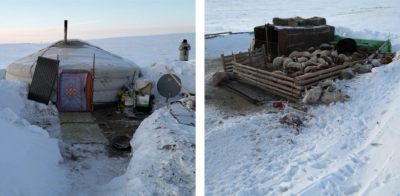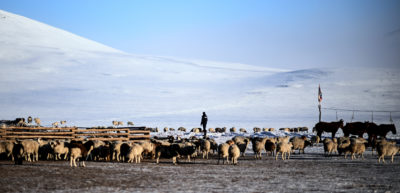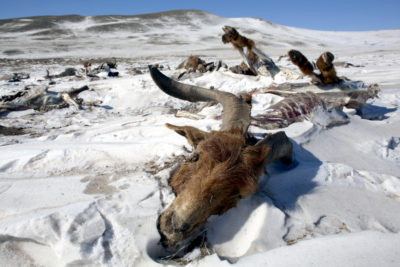The temperature was minus 45 degrees F when Uuganaa, a 27-year-old nomad with a wife and two children, woke to the howling winds outside his “ger,” a felt-covered traditional Mongolian dwelling. Sensing something amiss, he hurriedly put on his heavy fur coat and noted that another blanket of snow had fallen during the night. Then he shoveled his way outside.
Stepping outside, the air was so cold it condensed his breathe on his scarf and froze his eyebrows and eyelashes. Uuganaa had left more than a hundred goats and sheep outside the night before, but now they were nowhere to be seen. There were no trails either. He realized that his prized herd, which he had raised from birth with his aunt and uncle, was under more than 3 feet of snow. All had frozen to death.
This winter, 90 percent of Mongolia has been at risk from a deadly combination of extreme cold, heavy snow, and high winds — a phenomenon known as a “dzud.” Dzuds used to occur in this central Asian nation about once every decade, but there have been six in the past 10 years — a trend that scientists say is linked to climate change. Mongolians, who depend on their animals for food, fuel, and income, are now experiencing their second consecutive winter with a severe dzud. As of the last week of February, the number of dead animals reached more than 2.1 million, rising from 600,000 just two weeks earlier. Snowstorms have killed at least nine people, including one child.
When a dzud strikes, it is not a question of whether there will be death but of how many will die — people as well as animals.
Cold winters are typical in Mongolia. Livestock survive by moving, growing thick coats of fur, and pawing through snow and ice to grasses. But this winter, herds are struggling through both a “white” dzud, in which very deep snow hinders their access to grass, and an “iron” dzud, in which a brief thaw is followed by a rapid, hard freeze, locking pastures in ice.
In January, snowfall nationally was double the long-term average, with more than 13,500 households in snow-blocked areas. “I’ve never seen snow that is equal to the height of a ger in my life,” said Tserenbadam G., a nomad in her 70s. “This winter is particularly severe.” Scientists say that climate change is reshaping winter weather, leading to more extremes. Masses of frigid Arctic air are increasingly extending down over Mongolia, which is also seeing more snow. And the snow is falling all at once, says Batjargal Zamba, science advisor at Mongolia’s Information and Research Institute for Meteorology, Hydrology, and Environment, “rather than gradually over an extended period as observed in the past.”
Nomadic herders usually feel relief once they make it to Tsagaan Sar — the Lunar New Year, which signals the coming of spring and falls sometime between the end of January and the first few weeks of February. Tserenbadam celebrated Tsagaan Sar on February 10, anticipating warmer temperatures. But they have yet to arrive.
In Sukhbaatar Province, a nomad’s ger buried in snow (left), and a sheep pen (right) with the dead piled outside the fence.
TenGer TV
“It used to get warm right after the new year,” she said “Nowadays, it is getting even colder after Tsagaan Sar.” Other elderly nomads said they rarely witnessed people left with only a handful of animals out of hundreds after a dzud. But this year, with the dzud far from over, many herders are already in that position.
About a million herders in Mongolia depend for survival on their 65 million domesticated animals, which provide them with meat, milk, and a source of fuel, in the form of animal dung. Herders sell their animals’ hides, wool, and cashmere to buy food and pay their children’s school and university fees. Because of the loss of animals this winter, thousands of people have fallen into poverty.
When a dzud strikes, it is not a question of whether there will be death, but of how many will die — people as well as animals. Some herders perish trying to care for their animals. Others lose their lives looking for lost animals during snowstorms. (The National Emergency Operations Center has responded to at least 89 calls for missing people since November.) Sometimes snowstorms trap people in their homes day and night; without herders to keep them moving, animals freeze to death.
Summer droughts are a precursor for dzuds, as malnutrition makes livestock vulnerable to harsh winter conditions.
Dzuds also cut people off from basic services. With snow blocking the roads, it may take days for nomads to reach a grocery store in a “soum center” — a village-like settlement where nomads can purchase supplies. More than 40,000 households have now run out of fodder for their livestock; more than 13,000 households are in need of medical care; and close to 6,000 households have run out of food, according to the State Emergency Commission (SEC).
On February 14, the Mongolian government announced that it had elevated its disaster preparedness level to “high alert” and delivered fodder, food, gas, and medical supplies to herders. Government officials set about delivering 15 sacks of fodder per household in several provinces at highest risk. But for some remote provinces in the most sparsely populated country on the planet, supplies will take longer to arrive. The SEC clears snow from between 4,000 and 9,000 miles of roads a week, but heavy snow continues to fall, impeding the commission’s progress.
The United Nations and some international aid agencies have stepped in, too. The U.N. aims to mobilize $6.3 million for disaster relief. However, split between the nomads and their millions of animals, the funding would not afford, on average, more than two sacks of fodder per household, herders say. (A sack of fodder might sustain one sheep for approximately a week.)
A herder with horses and sheep in Tuv Aimak, Mongolia.
Britta Pedersen / Picture-Alliance via Getty Images
A dzud, with its mass mortality, doesn’t take nomadic people by surprise. Summer droughts are a precursor for them, as scarce forage leads to malnutrition, which makes livestock vulnerable to harsh winter conditions. Mortality rates are higher in combined drought and dzud years than in years with dzud or drought alone, according to a recent study.
Over the last half-century, droughts have been growing more frequent. Last year, 40 percent of Mongolia experienced drought and dry weather: Those summer conditions not only kept animals from storing fat, but also prevented herders from stockpiling sufficient fodder for the winter.
With climate change, dzuds are growing in intensity. One factor may be a weakening of the polar jet stream, a narrow band of fast-flowing wind circling the Earth. The jet stream is formed by the collision of cold, Arctic air with warmer air to the south, but with climate change, the Arctic is warming faster than other regions, narrowing the difference in temperature. This results in a weaker, more meandering jet stream that is allowing frigid polar air to reach down into Mongolia, Batjargal says.
Mongolia has seen a marked uptick in winter snow, which has grown by 40 percent, on average, since 1961.
Between 2000 and 2016, extreme cold hit Mongolia 28 percent more often than it did from 1981 to 1999, according to one study. And while total precipitation has changed little over recent decades, Mongolia has seen a marked uptick in winter snow, which has increased by 40 percent, on average, since 1961. The added snow cover has a cooling effect, making extreme cold more likely. The Intergovernmental Panel on Climate Change (IPCC) has said that Mongolia is “extremely prone” to natural disasters, and the situation for herders is likely to worsen in the years to come. Even if the world stays on track for around 2 degrees C of warming, dzuds are projected to strike up to 20 percent more often by 2080.
Herders responded to this year’s dzud by slaughtering their weakest animals, the ones they knew would not make it through the coming disaster. The oversupply of meat resulted in significant price drops, compounding herders’ challenges. However, regardless of preparation, the effects of a dzud of this magnitude cannot be mitigated. “For countrywide dzud events,” the IPCC reports, “high levels of livestock mortality are often unavoidable, even for the most experienced herders.”
The carcass of an animal that perished near Ulan Bator during the 2010 dzud.
Adam Dean / Bloomberg via Getty Images
But herders also bear some responsibility for their losses. Over the last 30 years, Mongolia’s livestock population has more than doubled, exacerbating desertification in three-quarters of the country. According to data from the Ministry of the Environment and Tourism, 49 percent of Mongolia’s desertification is caused by overgrazing, with the remaining attributed to climate change.
“Overgrazing creates drought-like conditions in the summer, and that increases the possibility of dzud occurrence in the winter,” Batjargal says. If livestock numbers were like those of the 1970s, he added, “we wouldn’t be seeing this many animal deaths.”
Yet despite the increasing frequency of dzuds, most government relief plans are only temporary. In 2010, a combination of black, white, and iron dzuds — caused by a drought, then heavy snow, then extremely cold temperatures and ice — led to the loss of more than 10 million animals, sparking food insecurity in various regions across Mongolia.
Some herders in remote regions view the government’s temporary relief programs as mere publicity campaigns.
On February 20, Mongolia’s Democratic Party proposed a one-time forgiveness of $340,000 in loans taken by nomads. But long-term adaptation strategies are still lacking. In the past, the government has, after supplying immediate relief, helped herders restock. However, the IPCC has suggested this approach is costly, relatively inefficient, and may fail to provide incentives for herders to minimize livestock mortality. “Restocking in areas with drought, poor pasture condition, and [with] unfit animals can actually increase livestock vulnerability in the following year as a result of greater competition for scarce resources,” the IPCC said. Still, temporary relief programs continue, and Mongolia’s agricultural ministry says it is planning to restock after this year’s dzud.
Some herders from remote regions view the government’s temporary relief programs as mere publicity campaigns. “Government officials don’t visit herders like me,” says a herder from Khuvsgul, the northernmost province bordering Russia. “Everyone [in the media] is saying that they’re delivering two sacks of fodder to everybody. My community hasn’t even seen a single kilogram [of fodder].”
Images shared on social media depict public servants eating meals provided by herders, a role reversal from their intended duties. Numerous herders expressed bewilderment at the sight of around 20 public officials in Jeeps traversing the country merely to give them two sacks of fodder.
The forecast for early March isn’t promising: severe snowstorms are set to sweep through the country starting this later week, with temperatures expected to plummet. The worst is yet to come: peak livestock mortality will occur between now and April. Many fear that these potential losses will surpass those of 2010’s black dzud.



